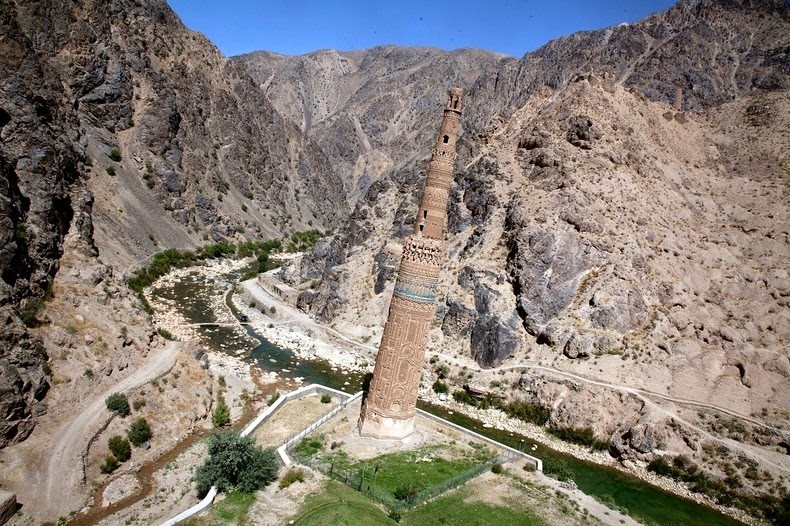The Minaret of Jam is located in Afghanistan’s Shahrak district on the banks of Hari river at a place where it meets river Jam around 215 km east of Herat. The magnificent 12th century minaret, rising 65 meters above the surrounding rugged valley is the only surviving monument from the Ghurid empire that ruled Afghanistan and parts of northern India, from Kashgar to the Persian Gulf, in the 12th and 13th centuries. The minaret was built in 1194 by the great Ghurid Sultan Ghiyas ud-Din (1153-1203), and its location probably marks the site of the ancient city of Firuzkuh, where the summer residence of the Ghurid emperors were located.
The minaret consist of four tapering cylindrical shafts stacked on top of each other, rising from an octagonal base and constructed of fired brick bonded with lime mortar. The exterior of the minaret is completely covered with geometric decoration in relief enhanced with a Kufic inscription in turquoise tiles. Surrounding the minaret are a group of stones with Hebrew inscriptions from the 11th to 12th centuries on the Kushkak hill, and remains of castles and towers of the Ghurid settlements on the banks of the Hari River.
The Minaret is accessible through a set of double spiral stairs that run from the octagonal base to the circular top, winding around each other like a DNA double-helix. The stairs end in an open chamber, from where you can look out over the confluence of the rivers. A second staircase continues from here up to the lantern gallery.
At the time of its construction, the Minaret of Jam was the tallest brick tower in the world, until the 20th century when the Qutub Minar in Delhi was constructed, also by the Ghurid Dynasty. The Minaret of Jam belongs to a group of around 60 minarets and towers built between the 11th and the 13th centuries in Central Asia, Iran and Afghanistan, as symbols of Islam's victory over the pagan populace. Others were simply landmarks or watchtowers.
There are indications that the Minaret was attached to a mosque which the Ghurid chronicler Juzjani states was washed away in a flash-flood, some time before the Mongol sieges. Archaeological research has found evidence of a large courtyard building beside the minaret, and evidence of river sediments on top of the baked-brick paving.
After the death of Ghiyas ud-Din his brother Muiz ud-Din succeeded him, but the Ghurid Empire started to wane and was forced to cede territory to the Khwarezm Empire. The dynasty’s last ruler was captured and put to death in 1215, and the town of Firuzkuh was destroyed by the Mongols in 1222.
The Minaret’s existence was lost to the world outside of Afghanistan until Sir Thomas Holdich reported it in 1886 while working for the Afghan Boundary Commission. It did not come to world attention, however, until 1957 through the work of two French archaeologists. The Minaret was again briefly cut off from outside world during the Soviet invasion in 1979.
The Minaret of Jam became Afghanistan's first UNESCO World Heritage site in 2002.

Sources: Wikipedia / UNESCO / Lonely Planet


















It appears to be leaning over in the 4th photo down from the top. None of the other pictures show this?
ReplyDeleteThe minaret had started to lean at one point but was restored.
DeleteAh so that's what happened. Thanks, I was worried it might fall.
ReplyDeleteSorry the minaret hasn't been restored. Work has been done around the base and it is now fenced off but it still leans as much as ever
ReplyDelete